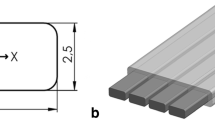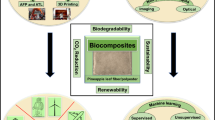Abstract
Luffa cylindrical (LC) has an exceptionally multipartite architecture, a hierarchical and light structure, and a low density. Such a structure is potentially suitable to replace conventional porous-type composites for low-energy absorption and material reinforcement applications. This paper presents an experimental study of the impact behavior of four different luffa/epoxy composites, named (A), (B), (C), and (D) subjected to low-velocity impact (LVI) at energies ranging from barely visible impact damage (BVID) to perforation (5,15, and 20J). Acoustic emission (AE), scanning electron microscopy (SEM), and digital image correlation (DIC) were introduced to the indentation test to offer additional information on damage mechanisms and on strain and displacement fields since the LVI test has a short duration and real-time damage monitoring is not always achievable. The results showed that the values of the peak force of laminates (A), (B), and (D) are relatively lower compared to laminates (C). In the case of perforation impact energy (20J), the Coefficients of Restitution (CoR) of composites (A), (B), and (D) are equal to 0, which indicates that the nature of the impact is completely plastic, except for composite (C) had a value of 0.11, and a lower degree of damage at all impact energies. Composites (C) exhibit the highest impact resistance, followed by composites (A), while composites (D) display the highest energy absorption, followed by composites (B). Multivariable statistical analysis of the AE signals identified four classes of damage: matrix cracking, fiber-matrix debonding, delamination, and fiber breakage. The damage modes found by AE are well presented and proven by SEM analysis. The luffa fiber-reinforced composite has better impact properties than other natural fiber-reinforced composites.





















Similar content being viewed by others
Data Availability
The datasets generated during and/or analysed during the current study are available from the corresponding author on reasonable request.
References
Kamath, S.S., Chandrappa, R.K.: Additives used in natural fibre reinforced polymer composites-a review. Mater. Today Proc. 50, 1417–1424 (2022)
Sanjay, M.R., et al.: Characterization and properties of natural fiber polymer composites: A comprehensive review. J. Clean. Prod. 172, 566–581 (2018)
Barouni, A.K., Dhakal, H.N.: Damage investigation and assessment due to low-velocity impact on flax/glass hybrid composite plates. Compos. Struct. 226, 111224 (2019)
Dhakal, H., et al.: The post-impact response of flax/UP composite laminates under low velocity impact loading. Int. J. Damage Mech. 28(2), 183–199 (2019)
Rubio-López, A., et al.: Compression after impact of flax/PLA biodegradable composites. Polym. Test. 59, 127–135 (2017)
Scarponi, C., et al.: Low-velocity impact behaviour of hemp fibre reinforced bio-based epoxy laminates. Compos. B Eng. 91, 162–168 (2016)
Puech, L., et al.: Investigating the impact behaviour of short hemp fibres reinforced polypropylene biocomposites through high speed imaging and finite element modelling. Compos. A Appl. Sci. Manuf. 109, 428–439 (2018)
Sy, B.L., Fawaz, Z., Bougherara, H.: Damage evolution in unidirectional and cross-ply flax/epoxy laminates subjected to low velocity impact loading. Compos. A Appl. Sci. Manuf. 112, 452–467 (2018)
Bar, M., et al.: Low velocity impact response of flax/polypropylene hybrid roving based woven fabric composites: Where does it stand with respect to GRPC? Polym. Test. 89, 106565 (2020)
Leroy, A., et al.: Are there similarities between quasi-static indentation and low velocity impact tests for flax-fibre composites? Ind. Crops Prod. 171, 113840 (2021)
Habibi, M., Abbassi, F., Laperrière, L.: Quasi-static indentation and acoustic emission to analyze failure and damage of bio-composites subjected to low-velocity impact. Compos. A Appl. Sci. Manuf. 158, 106976 (2022)
Kim, S.-W., et al.: Damage evaluation and strain monitoring of composite plates using metal-coated FBG sensors under quasi-static indentation. Compos. B Eng. 66, 36–45 (2014)
Grabi, M., et al.: Alkaline treatment’s effect on mechanical properties and damage assessment through acoustic emission of luffa fiber composite. Fibers Polym. 23, 2855–2865 (2022)
Saeedifar, M., et al.: Clustering of interlaminar and intralaminar damages in laminated composites under indentation loading using Acoustic Emission. Compos. B Eng. 144, 206–219 (2018)
Suresh Kumar, C., Arumugam, V., Santulli, C.: Characterization of indentation damage resistance of hybrid composite laminates using acoustic emission monitoring. Compos. Part B Eng. 111, 165–178 (2017)
Grabi, M., et al.: Strain and damage assessment of treated and untreated luffa mat composite using acoustic emission and digital image correlation. J. Nat. Fibers 19(16), 12536–12547 (2022)
Pan, B., et al.: Full-field transient 3D deformation measurement of 3D braided composite panels during ballistic impact using single-camera high-speed stereo-digital image correlation. Compos. Struct. 157, 25–32 (2016)
Cuynet, A., et al.: Damage characterisation of flax fibre fabric reinforced epoxy composites during low velocity impacts using high-speed imaging and Stereo Image Correlation. Compos. Struct. 202, 1186–1194 (2018)
Khadir, A., et al.: The prospective utilization of Luffa fibres as a lignocellulosic bio-material for environmental remediation of aqueous media: A review. J. Environ. Chem. Eng. 9(1), 104691 (2021)
Chen, Y., et al.: In-depth analysis of the structure and properties of two varieties of natural luffa sponge fibers. Materials 10(5), 479 (2017)
Grabi, M., Chellil, A., Grabi, H.: Effect of mat fiber lay-up and resin transfer molding process on fexural and tensile properties of luffa mat reinforced composites. J. Nat. Fibers 19(17), 15765–15778 (2022)
Grabi, M., et al.: Characterization of low-velocity impact and post-impact damage of luffa mat composite using acoustic emission and digital image correlation. J. Compos. Mater. 56(11), 1651–1665 (2022)
Bernaoui, A., Lebrun, G., Ruiz, E.: High performance natural fiber composites from mat and UD flax reinforcements backed with a mat Binder: A study of mat fiber surface fibrillation. Compos. A Appl. Sci. Manuf. 160, 107064 (2022)
Militello, C., et al.: Low-velocity impact behaviour of green epoxy biocomposite laminates reinforced by sisal fibers. Compos. Struct. 253, 112744 (2020)
Pantelakis, S.G., Katsiropoulos, C.V., Polydoropoulou, P.V.: Assessing the compression after impact behaviour of innovative multifunctional composites. Nanomater. Nanotechnol. 6, 1847980416679627 (2016)
Wang, C., et al.: On the mechanical behaviour of steel wire mesh subjected to low-velocity impact. Thin-Walled Struct. 159, 107281 (2021)
Mahesh, V., Joladarashi, S., Kulkarni, S.M.: An experimental investigation on low-velocity impact response of novel jute/rubber flexible bio-composite. Compos. Struct. 225, 111190 (2019)
Caprino, G., et al.: Low impact behaviour of hemp fibre reinforced epoxy composites. Compos. Struct. 133, 892–901 (2015)
Petrucci, R., et al.: Impact and post-impact damage characterisation of hybrid composite laminates based on basalt fibres in combination with flax, hemp and glass fibres manufactured by vacuum infusion. Compos. B Eng. 69, 507–515 (2015)
Dhakal, H., et al.: The low velocity impact response of non-woven hemp fibre reinforced unsaturated polyester composites. Compos. Struct. 81(4), 559–567 (2007)
Sarasini, F., et al.: Damage tolerance of carbon/flax hybrid composites subjected to low velocity impact. Compos. B Eng. 91, 144–153 (2016)
Fragassa, C., Pavlovic, A., Santulli, C.: Mechanical and impact characterisation of flax and basalt fibre vinylester composites and their hybrids. Compos. B Eng. 137, 247–259 (2018)
Ahmed, K.S., Vijayarangan, S., Kumar, A.: Low velocity impact damage characterization of woven jute—glass fabric reinforced isothalic polyester hybrid composites. J. Reinf. Plast. Compos. 26(10), 959–976 (2007)
Habibi, M., Laperrière, L.: Digital image correlation and acoustic emission for damage analysis during tensile loading of open-hole flax laminates. Eng. Fract. Mech. 228, 106921 (2020)
Acknowledgements
I would like to thank my parents for their help in the realization of this research work and the authors would like to thank the Laboratoire de Mécanique et Éco-Matériaux (LMEM) of the department of mechanical engineering, Université du Québec à Trois-Rivières, Quebec,Canada.
Funding
No funding provided.
Author information
Authors and Affiliations
Contributions
Massinissa Grabi: Realized the experiments, Writing, Original version, Methodology, Revision and editing, Visualization, Validation. Ahmed Chellil: Supervision. Samir Lecheb: Supervision. Hocine Grabi: Methodology, Supervision, Visualization. Abdelkader Nour: Performed the impact tests.
Corresponding author
Ethics declarations
Conflict of Interest
The authors declare no competing interests.
Additional information
Publisher's Note
Springer Nature remains neutral with regard to jurisdictional claims in published maps and institutional affiliations.
Rights and permissions
Springer Nature or its licensor (e.g. a society or other partner) holds exclusive rights to this article under a publishing agreement with the author(s) or other rightsholder(s); author self-archiving of the accepted manuscript version of this article is solely governed by the terms of such publishing agreement and applicable law.
About this article
Cite this article
Grabi, M., Chellil, A., Lecheb, S. et al. Impact Behavior Analysis of Luffa/Epoxy Composites Under Low-Velocity Loading. Appl Compos Mater (2024). https://doi.org/10.1007/s10443-024-10209-0
Received:
Accepted:
Published:
DOI: https://doi.org/10.1007/s10443-024-10209-0




